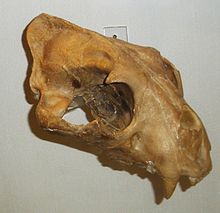Panthera onca augusta
| Panthera onca augusta Temporal range:
| |
|---|---|

| |
| Scientific classification | |
| Kingdom: | Animalia |
| Phylum: | Chordata |
| Class: | Mammalia |
| Order: | Carnivora |
| Suborder: | Feliformia |
| Family: | Felidae |
| Subfamily: | Pantherinae |
| Genus: | Panthera |
| Species: | |
| Subspecies: | †P. o. augusta
|
| Trinomial name | |
| †Panthera onca augusta Leidy, 1872
| |
| Synonyms | |
| |

Jaw of P. o. augusta at the Tellus Science Museum
Panthera onca augusta, commonly known as the Pleistocene jaguar or simply the giant jaguar, is an extinct subspecies of the jaguar that was endemic to North America during the Pleistocene epoch (1.8 mya–11,000 years ago).[1][2]
Fossil distribution[]
Fossils have been uncovered across the US; on the west coast in Adams County, Washington,[3] Oregon,[4] as well as at the famous La Brea Tar Pits,[5] and in Fentress County, Tennessee,[6] Franklin County, Tennessee,[7] Hamilton County, Tennessee,[8] Monroe County, Tennessee,[9] Van Buren County, Tennessee.[10]
In the east, fossil distribution ranged from Pennsylvania and Maryland to Florida.[11][12]
See also[]
- Pleistocene South American jaguar, P. onca mesembrina
- Panthera gombaszoegensis
- North American jaguar
- South American jaguar
References[]
- ^ PaleoBiology Database: Panthera onca augusta, basic info
- ^ Moreno, A. K. M.; Lima-Ribeiro, M. S. (2015-12-31). "Ecological niche models, fossil record and the multi-temporal calibration for Panthera onca (Linnaeus, 1758) (Mammalia: Felidae)". Brazilian Journal of Biological Sciences. 2 (4): 309–319. ISSN 2358-2731.
- ^ "Paleobiology Database: Panthera onca mesembrina, collections".
- ^ Richard L. Hill, 2006, Ice-age jaguar among fossil finds, The Oregonian
- ^ "Mammal Collections". tarpits.org. La Brea Tar Pits & Museum.
- ^ Watson, Patty J. et al. (2005). "Prehistoric Footprints in Jaguar Cave, Tennessee". Journal of Field Archaeology. 30: 25–43. doi:10.1179/009346905791072440. S2CID 129435588.CS1 maint: uses authors parameter (link)
- ^ McCrady, Edward; et al. (1951). "New finds of Pleistocene jaguar skeletons from Tennessee caves". Proceedings of the United States National Museum. 101 (3287): 497–512. doi:10.5479/si.00963801.101-3287.497.
- ^ Parmalee, Paul W. (1961). "A recent find of jaguar bones in a Tennessee cave" (PDF). Journal of the Tennessee Academy of Science. 36 (1): 81–85.CS1 maint: uses authors parameter (link)
- ^ Simpson, George Gaylord (1941). "Discovery of jaguar bones and footprints in a cave in Tennessee". American Museum Novitates. 1131: 1–27. hdl:2246/2259.CS1 maint: uses authors parameter (link)
- ^ "Big Bone Cave Class II Natural-Scientific State Natural Area". TDEC. Tennessee government: Division of Natural Areas. Retrieved March 14, 2018.
- ^ Schultz CB, Martin LD, Schultz MR (1985). “A Pleistocene Jaguar from North-Central Nebraska”. Transactions of the Nebraska Academy of Sciences and Affiliated Societies. Paper 228
- ^ https://www.biologicaldiversity.org/species/mammals/jaguar/pdfs/NM_jaguar_habitat_report.pdf
External links[]
| Wikispecies has information related to Panthera onca augusta. |
| Wikimedia Commons has media related to Panthera onca augusta. |
Categories:
- Jaguars
- Prehistoric pantherines
- Pleistocene carnivorans
- Pleistocene mammals of North America
- Pleistocene mammals of South America
- Prehistoric mammals of North America
- Pleistocene first appearances
- Pleistocene extinctions